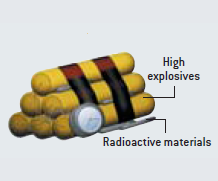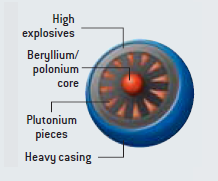
Dirty bomb:
- Explosives combined with radioactive materials
- Detonation vaporizes and aerosolizes radioactive material and propels it into the air dispersing and contaminating the air and affected surfaces with radioactive isotopes.
- Not a nuclear detonation
- Inhalation and skin contamination are concerns met with removal of contaminated clothing, washing of skin, and potentially use of isotope specific decorporation agents (i.e. DTPA, etc) to remove internalized radioactive material.
|

Fission bomb: one example
- Caused by a mass-limited but uncontrolled nuclear chain reaction with uranium-235 or plutonium-239
- Fission weapons have uranium-235 or plutonium-239 surrounded by conventional explosives designed to implode toward a central sphere of the isotopes to force criticality
- Initiation of a centrally directed implosion of conventional explosives around the uranium or plutonium produces a compressive shock wave directed toward the central sphere. The weapon contains pellets of beryllium/polonium which increase the flux (incursion) of neutrons which enhance the ability to create "criticality",ie., the initiation of U-235 or Pu-239 chain reactions to fission (splitting) and release of massive nuclear sourced energies resulting in a nuclear explosion
|



